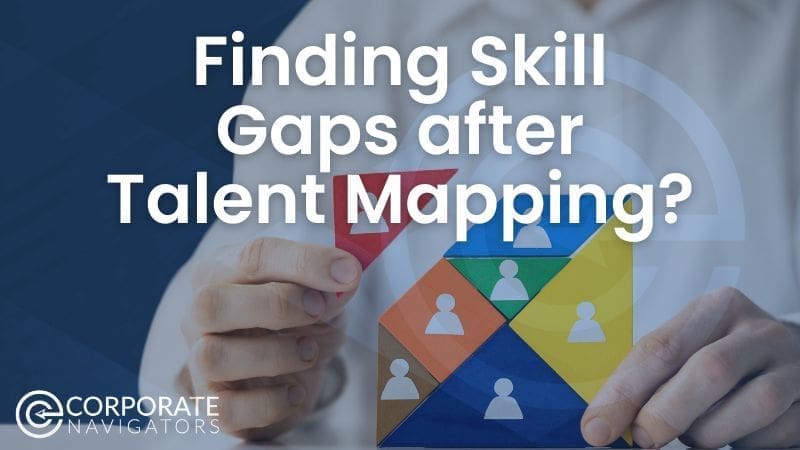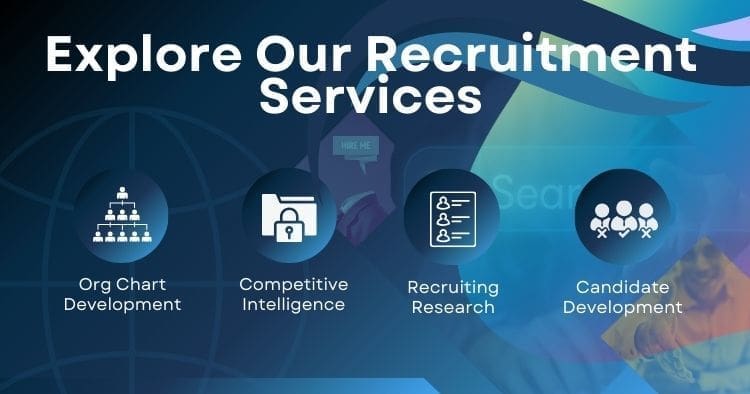
Table of Contents
What do you do when you find a skill gap?
When organizations conduct talent mapping, it’s not unusual to find skill gaps, especially when you’re in a stage of growth or change. When this occasion arises, it’s important to find a qualified person to fill the empty role. At Corporate Navigators, our Research and Recruitment Teams can find potential candidates who match all your talent acquisition criteria – closing the skill gap.
What is Talent Mapping?
Talent Mapping is a routine evaluation of staff that companies conduct to identify strengths and weaknesses in their workforce. Results often come in the form of a chart or list of people ranked according to their strengths, weaknesses, and potential.
The talent mapping process is a vital practice to gauge future hiring needs, identify the best talent and competencies in your company, and to see if further training is necessary for existing employees.
Through doing a full screening of teams, companies may find skill gaps in this process. Thankfully, voids can be filled through continued training, promoting high-potential employees from within – or recruiting talent through a hiring process.
Example of Talent Mapping
Here is an example of a generic talent map. When the results are complete, it’s easy to identify top employee performance, future talent needs, and who is most likely to advance.

[Source: Someka]
Talent maps typically have two main components that run across x and y axes. On this grid, employers classify their existing workforce after reviewing employee skills, performance, competence, and potential.
The Performance Axis: This is typically the horizontal “x” axis. The better the performance, the more far along the employee belongs on this spectrum. Metrics used to place the employee include performance evaluations, skills assessments, employee experience, and past contributions. Soft skills like adaptability, teamwork, organization, active listening, and innovation may also be qualitative factors on this axis.
The Potential Axis: This is typically the vertical “y” axis that assesses an employee’s professional potential. Based on past performance and current skills, how capable are they to grow and take on key roles? Qualifiers in this axis include ability to learn, leadership skills, strategic thinking skills, and overall competence. Soft skills like emotional intelligence, communication skills, responsiveness, and conflict resolution are further examples of factors considered.
Overall, implementing an effective talent mapping strategy can help HR Teams and hiring managers navigate staffing issues, prepare to hire for new roles, and know when to pursue talent development services when they hit a dead end.
How Does Talent Mapping Benefit You?
Talent mapping is an invaluable tool for any organization that wants to make the most of its workforce, budget, and talent management strategy. It’s worthwhile to do in any stage of growth and development since it offers substantial benefits for internal operations and workforce planning.
1. A Full Outlook: Talent mapping gives a full outlook of a company’s departments, making it easier for employers to predict long-term hiring needs and get a head start on filling roles and onboarding without feeling rushed.
- Tip: When you identify what’s required, a Candidate Sourcing Company can accelerate your timeline in finding the right candidate.
2. Maximize What You Have: Talent mapping allows employers to make the most of their existing dossier and promote internally while also identifying leadership and skill gaps. By knowing what kind of person is missing to complete future goals, companies can direct their energy properly and not waste time or energy elsewhere.
3. Identify What You Really Need: As a company expands, hiring needs can be difficult to discern, especially when there are multiple goals pursued. This business strategy benefits everyone from human resource professionals to recruiters to identify what the company really needs to grow in the desired direction.
4. Motivate and Recognize Existing Talent: Existing team members can also gain recognition and promotion through consistent talent mapping. By assessing their skill growth and track record, employers can mitigate talent shortages by identifying hidden gems in their ranks, allowing companies to use their workforce in optimal ways and unnecessary loss of high-potential talent that go elsewhere due to lack of opportunities.
5. Discovers Weaknesses That You Can Address Professionally. This strategic approach also uncovers weaknesses in teams, such as in leadership skills, providing opportunities to retrain and upskill existing talent to improve performance and potentially prevent attrition.
How often should I map talent at my company?
The majority of companies do this type of evaluation at least once a year. However, best practices strongly recommend companies do a talent mapping exercise twice a year, especially if the organization is in a stage of rapid growth or change.
Gathering this important data can help companies understand where they stand and what they need to improve their ranks, so doing this more frequently is beneficial to stay ahead of the winds of change. Also, since the talent market is always changing along with your business needs, fresh internal data will help you best recognize when it’s time to start a recruitment process for new leaders or the right talent for a discovered skill gap.
Questions to Ask Yourself as You Talent Map
As you begin to map talent, it’s important to make the most of your time. Asking the right questions is a great starting point.
- Q: Where does your company want to be in the short and long term?
- Q: Has your company experienced major changes, such as changes in leadership, or a significant shift in business processes?
- Q: Do you have major plans to change within the next five years? Do you foresee the need for structural change to meet these new goals and initiatives?
- Q: In which departments do you hear of the most complaints or lack of performance?
- Q: What skill sets do your teams need to meet quarterly and annual goals but don’t currently have?
As you can see, talent mapping can address a variety of issues by putting the right candidates in missing positions to benefit your organization.
Do You Need Support after Talent Mapping?
With talent mapping, employers can identify key employee characteristics like experience, abilities, competence, and potential. If your organization has identified skill gaps that you cannot cover internally, you can use this data to ideate the exact list of criteria required for a new hire.
When your company needs to find qualified candidates after talent mapping, Corporate Navigators can provide the extra support and information required to make informed hiring decisions.
Finding Candidates after Talent Mapping
Getting help with your recruitment needs is a streamlined process. First, you reach out to us and fill out an intake form in which you describe what kind of person you need to fill a role. You may also have us look into different sources upon your request.
Then, our Research Team gets to work on identifying eligible, qualified candidates and compiles a list of people that you can contact. If you would like to take this a step further, we can develop these candidates by calling them to verify eligibility, interest, and other criteria under your specification.
After this process, we will send you the results of our research and candidate development process so that you have a curated list of interested candidates to contact. With a full list of options, you are now empowered to make the best business decisions.




